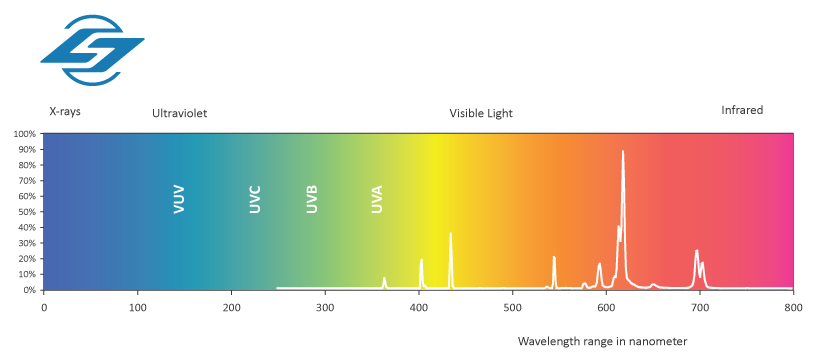Not known Factual Statements About Uvc Light
Not known Factual Statements About Uvc Light
Blog Article
The smart Trick of Uvc Light That Nobody is Discussing
Table of ContentsHow Uvc Light can Save You Time, Stress, and Money.The Buzz on Uvc Light6 Easy Facts About Uvc Light ShownThe Facts About Uvc Light UncoveredFacts About Uvc Light UncoveredHow Uvc Light can Save You Time, Stress, and Money.
A brand-new sort of ultraviolet light that might be risk-free for people took less than five mins to reduce the level of interior air-borne microorganisms by even more than 98%, a joint research study by researchers at Columbia College Vagelos University of Physicians and Surgeons and in the U.K. has located. Even as microorganisms proceeded to be sprayed into the area, the degree remained extremely reduced as long as the lights were on.However previously these research studies had actually only been conducted in tiny speculative chambers, not in full-sized rooms imitating real-world problems. In the existing study, scientists at the University of St. Andrews, University of Dundee, University of Leeds, and Columbia College evaluated the efficiency of far-UVC light in a huge room-sized chamber with the very same ventilation rate as a typical home or office (about three air changes per hour).
The efficacy of different methods to minimizing interior infection degrees is normally gauged in regards to equal air adjustments per hour. In this research, far-UVC lights generated the matching of 184 comparable air exchanges per hour. This exceeds any type of other method to sanitizing occupied indoor spaces, where 5 to 20 comparable air modifications per hour is the very best that can be attained practically.
The Best Strategy To Use For Uvc Light

The major criteria of UV-C sanitation are wavelength, dose, family member moisture, and temperature. There is no agreement concerning their ideal worths, yet, as a whole, light at a high dose and a spectrum of wavelengths consisting of 260 nm is preferred in a setting at area temperature with low loved one humidity. This light can be created by mercury-vapour, light-emitting diode (LED), pulsed-xenon, or excimer lamps.
Likewise, there are health and wellness risks related to the UV-C technology when used in the proximity of individuals. UV-C sanitation systems have appealing attributes and the prospective to enhance in the future. However, information bordering the various parameters influencing the innovations' performance in medical facility setting are required. UV-C sanitation should presently be thought about for low-level rather than high-level sanitation.
Another application developed in 1910 when UV light was made use of to sanitize water. However, the technology was not very reputable at the time and it took further technological advancements before UV water sanitation ended up being prominent once more in article the 1950s [ 2] Nowadays, UV light is utilized for water, air, food, surface area, and medical equipment sanitation.
Uvc Light Can Be Fun For Everyone
DNA, RNA, or healthy proteins of a micro-organism take in UV light, with a peak absorbance around 260 nm [6] This results in the disturbance of DNA or RNA, bring about the inactivation of the micro-organism. UV-C-induced DNA disturbance typically includes the bonding of 2 neighbouring thymine (or cytosine) bases as opposed to the conventional connecting of a base with its corresponding base upon the various other hair.

The UV-C zone is used for sanitation but there is no agreement on the exact optimal wavelength. Light at 260 nm can cause the most disruption. Numerous micro-organisms are most susceptible to slightly various wavelengths.
How Uvc Light can Save You Time, Stress, and Money.
It even has an added benefit by minimizing photoreactivation with a decrease of photolyase [9] On the various other hand, it has technical ramifications since the total energy of the light beam is then separated over all existing wavelengths. Therefore, a micro-organism that is prone to 254 nm light will be suspended more by a light that releases only light at 254 nm than a lamp that releases a wavelength range at equal complete power.
Exposure times of 1045 min for space sanitation and 25 s to 5 min for medical devices were run into in literature. The intensity is inversely proportional to the settled distance in between the light source and the surface and is therefore specified at the surface area in the dosage computation formula [14]
Better, the outcome of a lamp reduces over time, so it is suggested to compute the dose at the end of lamp life, which is rep of a worst-case scenario. The dose additionally influences the amount of photoreactivation.
The impact of temperature level depends on the light resource.
The 6-Minute Rule for Uvc Light


This is called much UV-C technology and is a relatively new sanitation technique with minimal knowledge about its performance. This makes it riskier to totally rely on this technology for sanitation in the medical facility and it is as a result not widely made use of [21] It additionally has benefits such as a decreased risk for use near people due to a lower infiltration depth into the skin and eyes [ 26]
In research study, the results on pulsed versus continual UV-C sanitation effectiveness differ. When why not try here contrasting pulsed and continuous light it is very important to keep other variables such as wavelength and dose consistent. Nyangaresi et al. and Sholtes et al. both located that pulsed or continuous light produced by LEDs brought about equivalent log10 reductions [15,28]
The Greatest Guide To Uvc Light
In instance ozone is not needed for disinfection, a customized lamp can be used. For mercury-vapour lights, doped quartz glass or specialized soft glass can filter out short-wave UV-C light. For pulsed-xenon, drugged quartz can be made use of as well [30] UV-C has promising attributes for disinfection such as automated disinfection, being much less taxing than widely used manual or chemical disinfections, leaving no dangerous residuals, and being eco-friendly (if no mercury-vapour lamps are made use of) [31,32]
Report this page